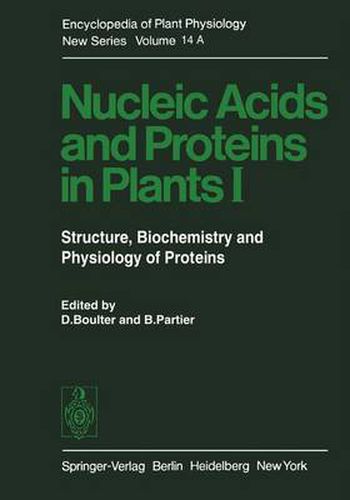Readings Newsletter
Become a Readings Member to make your shopping experience even easier.
Sign in or sign up for free!
You’re not far away from qualifying for FREE standard shipping within Australia
You’ve qualified for FREE standard shipping within Australia
The cart is loading…






This title is printed to order. This book may have been self-published. If so, we cannot guarantee the quality of the content. In the main most books will have gone through the editing process however some may not. We therefore suggest that you be aware of this before ordering this book. If in doubt check either the author or publisher’s details as we are unable to accept any returns unless they are faulty. Please contact us if you have any questions.
D. BOULTER and B. PARTHIER At the time of the former edition of the Encyclopedia of Plant Physiology, approximately 25 years ago, no complete plant protein amino acid sequences or nucleic acid sequences had been determined. Although the structure of DNA and its function as the genetic material had just been reported, little detail was known of the mechanism of its action, and D. G. CATCHSIDE was to write in the first chapter of the first volume of the Encyclopedia: There is a consider able body of evidence that the gene acts as a unit of physiological action through the control of individual enzymes . No cell-free transcription and pro tein-synthesizing systems were available and the whole range of powerful meth ods of recombinant DNA technology was still to be developed. Today for the first time with plant systems, it is possible not only to describe their molecular biology but also to manipulate it, i. e. , to move from a description to a technological phase. The properties of living systems are inscribed by those of the proteins and nucleic acids which they synthesize. Proteins, due to their very large size, occur as macromolecules in colloidal solution or associated in supra-molecular colloi dal form. The colloidal state confers low thermal conductivity, low diffusion coefficients and high viscosity, properties which buffer a biological system from the effects of a changing environment. Biological systems not only have great stability, but also the capacity to reproduce.
$9.00 standard shipping within Australia
FREE standard shipping within Australia for orders over $100.00
Express & International shipping calculated at checkout
This title is printed to order. This book may have been self-published. If so, we cannot guarantee the quality of the content. In the main most books will have gone through the editing process however some may not. We therefore suggest that you be aware of this before ordering this book. If in doubt check either the author or publisher’s details as we are unable to accept any returns unless they are faulty. Please contact us if you have any questions.
D. BOULTER and B. PARTHIER At the time of the former edition of the Encyclopedia of Plant Physiology, approximately 25 years ago, no complete plant protein amino acid sequences or nucleic acid sequences had been determined. Although the structure of DNA and its function as the genetic material had just been reported, little detail was known of the mechanism of its action, and D. G. CATCHSIDE was to write in the first chapter of the first volume of the Encyclopedia: There is a consider able body of evidence that the gene acts as a unit of physiological action through the control of individual enzymes . No cell-free transcription and pro tein-synthesizing systems were available and the whole range of powerful meth ods of recombinant DNA technology was still to be developed. Today for the first time with plant systems, it is possible not only to describe their molecular biology but also to manipulate it, i. e. , to move from a description to a technological phase. The properties of living systems are inscribed by those of the proteins and nucleic acids which they synthesize. Proteins, due to their very large size, occur as macromolecules in colloidal solution or associated in supra-molecular colloi dal form. The colloidal state confers low thermal conductivity, low diffusion coefficients and high viscosity, properties which buffer a biological system from the effects of a changing environment. Biological systems not only have great stability, but also the capacity to reproduce.